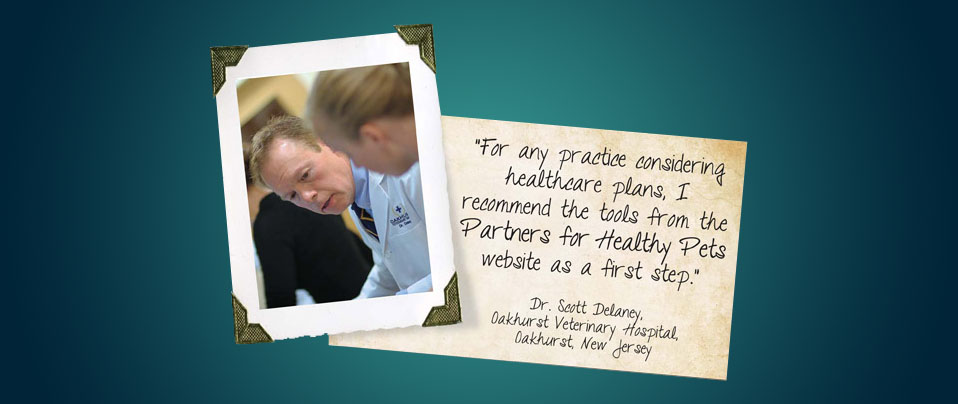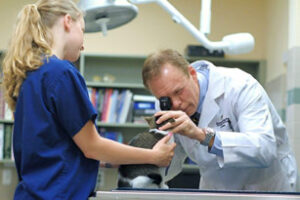Implementing Monthly Payment Plans

Making Preventive Healthcare More Accessible to Pet Owners
Online Tools Help Create Preventive Pet Healthcare Plans that Work
Introducing preventive pet healthcare payment plans is a major step for any veterinary practice. When Dr. Scott Delaney of Oakhurst Veterinary Hospital (OVH) in Oakhurst, NJ saw the Partners for Healthy Pets online resources for implementing pet healthcare plans, he thought, ‘This is fantastic! They’ve laid it all out for us.’
“The ‘Partners’ suite of tools for developing pet healthcare plans made a challenging task manageable and ensured that our plans would be properly done from day-one and well accepted by our clients,” Dr. Delaney says. The result is OVH’s “Best Years Gold” and “Best Years Silver” plans for adult canine and feline preventive healthcare as well as puppy and kitten plans for pets under nine months of age.
“By introducing preventive healthcare plans to our clients, we’ve adopted a business model that we believe will improve pet owner compliance, keep our patients healthier, and help our practice prosper.”
Rationale for preventive healthcare plans

Preventive pet healthcare plans with a monthly payment option are receiving new emphasis in companion animal medicine as a way of making preventive care services more accessible to pet owners. The recent Bayer Veterinary Care Usage Study focused attention on the role preventive healthcare plans could play in reversing recent trends in declining utilization of professional veterinary care. Despite a canine and feline population that has grown by more than a third during the past decade, survey data showed that active clients per veterinarian declined by 17% from 2001-2009 and more than half of veterinarians had fewer patient visits in 2010 compared with a year earlier.1 The Bayer Study found that 45% of pet owners said that a wellness program billed in monthly installments would increase the likelihood they would take their pets to a veterinarian.2 The only factor cited more often was ‘competitive product prices’, mentioned by 47% dog and cat owners. The third most popular veterinary service requested by pet owners was a “full-year health program spelled out” for pets, mentioned by 39% of survey respondents.
The appeal of preventive healthcare plans becomes evident in view of their mutual benefits for pet owners and veterinary practices. These include:
- Neutralizing “sticker shock” from single-billing for preventive services.
- Enabling clients to budget for preventive health care on a monthly basis.
- Creating regular “touch points” between the healthcare team, its clients, and patients.
- Providing an opportunity to promote the importance of preventive healthcare to improve and extend the lives of pets.
- Providing more dependable care for patients that are seen for preventive care exams on a regular basis.
- Using regular screenings and exams to reduce the potential for avoidable chronic and acute disease.
- Creating a stream of predictable cash flow for the practice.
- Using healthcare plan incentives to bond clients more closely to the practice.
For Scott Delaney, the principal motivation for offering healthcare plans was to move clients to a greater level of compliance. “If we make preventive healthcare more accessible through a payment plan for specific services,” he says, “pet owners will be more compliant and our patients will receive more consistent care.” He cites heartworm prevention as a good example of how the plan itself influences compliance.
“Our practice is located in a coastal area with a seasonal climate where year-round heartworm prevention is a good idea,” he explains. “As part of both of our adult plans, we include a full year’s supply of internal and external parasite control medication at a discounted price. Because a year’s supply of preventive medication has been pre-purchased as part of the plan, the client is much more inclined to be fully heartworm-compliant than someone who buys parasite control medication separately in monthly or six-month supplies.”
Terms and Conditions Disclaimer Used in OVH Healthcare Plans
Preventive healthcare plan contracts (sometimes called “agreements”) identify the specific client and patient, the services included in the plan, and the price. The limits and exclusions in a good healthcare plan are as important as what is included. The Preventive Healthcare Plan Contract used at Oakhurst Veterinary Hospital includes the following terms and conditions that define the plan’s limits:
- The plan is NOT pet insurance. This is a preventive plan and is not intended for the diagnosis or treatment of disease or injury.
- Preventive care does not guarantee the health of the pet. The goal of preventive care is to reduce the risk of disease and to improve the overall wellness of the pet.
- This plan is only for the pet named in the contract. It is not transferable to another pet.
- This plan only covers the services specifically listed in the contract.
- All other services must be paid in full at the time services are rendered.
The Partners for Healthy Pets web site (PartnersforHealthyPets.org) Resources Toolbox, Preventive Pet Healthcare Plans tab provides examples of what should be included in a healthcare plan, including services, fee considerations, and terms of the agreement.
“It makes perfect sense”
Dr. Delaney and his business partner first became interested in preventive healthcare plans after hearing a presentation about them at a national veterinary conference. “We did some informal polling of our clients about whether they would be interested in a preventive healthcare plan billed in monthly payments,” he says. “We were especially interested in the response of clients who expressed concerns about the costs of our services. The response we received was strongly and consistently favorable about healthcare plans. Clients were telling us in so many words, ‘We would love to pay for a preventive care plan on a monthly basis.’ Our informal probing convinced us that preventive healthcare plans represent an unmet need in our practice and in companion animal medicine generally.
“If you think about spreading healthcare plan costs over 12 months, it makes perfect sense. No one suggests paying your electric bill in one annual payment. Instead, we make monthly payments for many services we use on a regular basis, such as insurance premiums, fitness clubs, telephone service, and so forth. A monthly payment plan can be successfully used in veterinary medicine, too.”
A preventive healthcare plan has multiple components. It involves deciding which services will be included, the fee structure that will yield a positive return on investment, whether to include discounts to incentivize participation, and terms and conditions of the plan contract (see box). After involving and training the healthcare team to administer and manage the plans, they must be rolled out to the client base. “You need to end up with a defect-free end product,” Dr Delany points out. “Once you implement a plan, you’ve made binding agreements with your clients. It’s very difficult to change or revoke it a plan once it’s in effect.”
As the OVH staff anticipated, implementing a healthcare plan required time and commitment. Dr. Delaney estimates that more than 100 man-hours were required to develop the plans for his practice. For him and his staff, making the leap from healthcare plan concept to implementation benefited greatly from the professionally produced, freely available materials in the Partners for Healthy Pets online Resources Toolbox.
Partners for Healthy Pets Preventive Pet Healthcare Plan Tools

Partners for Healthy Pets provides several online resources for veterinary practices to use to develop preventive healthcare plans. Available at Partners for HealthyPets.org, these professionally produced materials can be downloaded as pdf documents or PowerPoint slide presentations. The resources include:
- An Overview document that describes the benefits and key elements of preventive healthcare plans, and case study examples from veterinarians who have used plans in their practices.
- A detailed Implementation Manual that discusses designing and managing a plan, involving the healthcare team in administering the plan, marketing the plan to clients, and key performance indicators that measure the impact of healthcare plans on the practice.
- Worksheets in spreadsheet and document formats for plan pricing.
- A Team Training Manual that explains the individual roles and responsibilities of healthcare team members in developing and implementing healthcare plans.
- A Preventive Healthcare Plans slide presentation, customizable for individual practices, for team training purposes. The slides can be modified to include plan details and pricing specific for each practice.
While the Partners online healthcare plan tools are detailed and comprehensive, they are organized in manageable increments that progress from the general (Overview) to the specific (Implementation Manual, Team Training Manual). “The amount of online material was not intimidating because the tools are all pertinent,” Dr. Delaney notes. “What was intimidating was the decision to implement healthcare plans in the first place. The Partners online tools made the implementation feasible and considerably less daunting. In fact, the more we read the resource materials, the more convinced we became that preventive healthcare plans were the right thing to do for our practice.”
The OVH staff used all of the Partners online tools to develop their preventive healthcare plans. “Together, these resources provided us with an excellent blueprint for accomplishing a complex task in a step-by-step manner. The end result was what we believe are first-rate preventive healthcare plans, customized for our practice.”
Tips for implementing preventive healthcare plans
Dr. Scott Delaney of Oakhurst Veterinary Hospital introduced preventive healthcare plans after a careful planning process and with the help of the online resources available from Partners for Healthy Pets. Based on that experience, he offers several tips for veterinarians considering healthcare plans for their practices:
- Conduct a trial run. Prior to introducing healthcare plans to its entire client base, OVH invited a select group of clients to enroll to ensure that all aspects of the plan work as expected.
- Emphasize that the plan is not health insurance. Preventive healthcare plans do not cover acute or urgent care, only regularly performed services. To avoid any misunderstanding, this point is prominently mentioned in the Terms and Conditions section of the OVH healthcare plan contract. The OVH staff recommends supplementing their preventive healthcare plans with pet insurance.
- Incentivize enrollment. In addition to a discount on preventive healthcare services, OVH healthcare plans offer other incentives for clients to enroll, such as discounts for non-plan services. These include unlimited free TNT (“toe nail trims”), free dental consultation during the wellness visit, as well as select discounts on one medical problem consult, all lodging, and all baths. Every visit for the non-plan services increases client utilization of the practice and an opportunity for the practice to reinforce its relationship with the pet and its owner.
- Have puppy and kitten plans. Enrolling pets early in life increases the likelihood that they will be lifelong participants in comprehensive preventive healthcare.
- Use other service providers. Rather than assuming responsibility for all aspects of administering preventive healthcare plans, various service providers are available that can provide assistance. OVH uses PaymentBanc® for electronic payment services and ImproMed® total-solution software that can be adapted to healthcare plan administration. The Overview tool provides a list of other service providers that can assist with developing or administering preventive healthcare plans.
- Encourage a full-payment option. The appeal of healthcare plans for most clients is to spread the cost across a monthly payment schedule. Some clients with the financial means to do so actually prefer paying the annual fee in a single payment up-front, often with a credit card. This option should be mentioned because it helps ensure that the paid-in-full client will be fully compliant for the coming year. Some plans offer an additional discount for clients who make full payment for the plan at the outset.
- Segment healthcare-compliant clients from non-compliant clients. Clients who are already fully compliant and enroll in a healthcare plan are, in effect, receiving a reward in the form of discounted fees for services they already use on a regular basis. In contrast, non-healthcare compliant clients are the ones who will most enrich the wellbeing of their pets by enrolling in a plan. The primary goal is to enroll new clients, clients who introduce a puppy or kitten to the practice, and current clients who are non-compliant and use the practice only for vaccinations and urgent care since the pets owned by these client segments will benefit the most from enhanced preventive healthcare.
How OVH used the online tools
In developing their preventive healthcare plans, the OVH staff decided to include the same services they would use for their own pets. They discounted the total fee by 32% and marketed it as “Canine (or Feline) Adult Best Years Silver Preventive Healthcare Plan”. Comparable “Gold” plans that added a “Prevent-Dent” dental exam and prophylaxis were also developed. The Silver and Gold adult plans were for patients from 9 months to 10 years of age. Younger pets can be enrolled in puppy and kitten plans and a senior plan will eventually be introduced. In pricing the various services included in the plans, Dr. Delaney wanted to arrive at a monthly payment below the threshold of price resistance. In doing the price calculations, the worksheets available on the Partners web site proved to be invaluable.
“I use spreadsheets all the time in managing our practice,” Dr. Delaney says, “so the online worksheet in Excel format was an extremely valuable tool for developing our healthcare plans. The worksheets helped us determine the monthly fee that most clients would accept and the level of discount that would still yield a positive return versus a non-discounted fee-for-service model.”
Two other online tools that were especially useful at OVH were the Team Training Manual and the Preventive Healthcare Plans slide presentation for internal training use. The entire OVH healthcare team participated in a training program to implement the practice’s healthcare plans. “Unless we sold the healthcare plan concept to our staff, there is no way we could convince clients to purchase a plan,” Dr. Delaney says. “We used staff training to explain the purpose of the healthcare plans, the content of our plans, and everyone’s individual role in implementing the plans in our practice. The staff responded very positively to the training experience. There were a lot of questions and discussion during the training sessions, which was a good sign. The staff became fully committed to what we’re trying to do. That was a direct result of the quality and professionalism of the training materials.”
Dr. Delaney customized the slide presentation tool in several ways to make it specific to OVH. Photos of the hospital were added and slides were created to show the content of the various OVH healthcare plans and how employees would be compensated for plan services.
The Implementation Manual was a critical tool for helping Dr. Delaney craft a contract for clients who enroll in an OVH healthcare plan. For example, the services covered by the plans, the amount of a one-time enrollment fee, discounts for non-plan services, payment options, and cancellation and refund policies are components of the OVH contract that are all discussed in the Implementation Manual.
Dr. Delaney took careful notice of the chapter in the Implementation Manual on how to market healthcare plans. The manual emphasizes the importance of using multiple ‘touch points’ to introduce healthcare plans to clients. These include electronic and social media, print literature, invoice messaging, press releases, open houses, telephone discussions, and in-person dialog with clients. “The Manual describes various client communication scenarios that we found very helpful,” he says. “These include ways that every member of the healthcare team, from practice owner to kennel attendant, can promote healthcare plans to clients.”
A Golden Opportunity
Most of Scott Delaney’s colleagues in other practices do not offer preventive pet healthcare plans. “Healthcare plans are very much in their infancy in the veterinary medical profession,” he says. “It’s a golden opportunity for most practices to improve their quality of care. A key success factor in implementing healthcare plans is to be absolutely committed to taking this step for improving the practice. It takes a considerable amount of time to do the job properly. For us and probably for most practices, it would have been nearly impossible to introduce healthcare plans without the Partners online resources. The Partners web site explained the pros and cons of healthcare plans and mapped out the development process and the check steps from step-one to completion. For any practice that is considering healthcare plans, I recommend downloading the healthcare plan tools from the Partners web site as a first step.”

Oakhurst Veterinary Hospital has only recently begun introducing its preventive healthcare plans to its clients. It will be a year or more before the impact of the plans on the practice will be known, but Dr. Delaney is hopeful about the prospects. “I’m excited because I believe most clients will like having a financially manageable healthcare plan to protect the wellbeing of their pets, and because our staff is committed to the success of this initiative. I’m optimistic that our plans will be accepted because they are very well designed. We’re prepared for success and we give full credit for that to the resources provided by Partners for Healthy Pets.”
References
- American Animal Hospital Association-American Veterinary Medical Association Preventive Healthcare Guidelines Task Force. Development of new canine and feline preventive healthcare guidelines designed to improve pet health. J Am Anim Hosp Assoc. 2011;47:306-311.
- Volk JO, Felsted KE, Thomas JG, et al. Executive summary of the Bayer veterinary care usage study. J Am Vet Med Assoc. 2011;238:1275-1282.
Tools of Interest
The following tools helped this hospital:
Read what your colleagues are saying about their experiences using specific Partners for Healthy Pets tools.
Success Stories are testimonial case studies of the benefits realized by patients and practices as a result of utilizing the Resources Toolbox!

